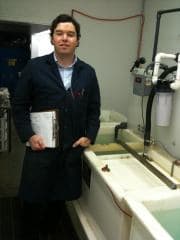
Curated with aloha by
Ted Mooney, P.E. RET

The authoritative public forum
for Metal Finishing 1989-2025

-----
Silver Plating with Auxiliary Anodes
Quickstart: Plating thickness builds in proportion to where the current flows; and electricity tends to take the shortest path. So some irregularity in thickness will usually occur, and there are situations, like when needing to plate the ID of a tube, where 'auxiliary anodes' (metallic objects connected to the anode side of the circuit), will be required inside the tube or protruding into very deep dish hollows. Auxiliary anodes are not usually made of the plating metal but of chemically resistant materials, sometimes called dimensionally stable anodes.
Q. Hello everyone, I hope you can help me with my problem, we have a silver solution of 500 lt, 16 g/l of silver cyanide, 120 g/l of potassium cyanide, the brighteners are within the range, we make silver coatings on musical instruments of brass.



When we do the silver plating we have deposits in internal areas of a dark black tone that comes off easily and the brass is exposed very clean matte,; does anyone know what could be happening? We made a hull cell and the tests come out fine; this It only happens with large pieces, with small pieces everything is fine.
HECTOR DIAZ- MEXICO/ ESTADO DE MEXICO
July 28, 2023
A. Hi Hector.
The plating only goes where the current flows, and in direct proportion to it. But the current tries to take the path of least resistance, and there is no current flowing to the interior of the long mouthpieces.
I don't think you will be able to plate them except with an auxiliary anode (a wire running through the center of the mouthpiece, and connected to the anode).
Luck & Regards,

Ted Mooney, P.E. RET
Striving to live Aloha
finishing.com - Pine Beach, New Jersey
Q. Hello Ted Mooney, we already did that test, we placed an auxiliary stainless steel anode that passes in the middle of the hood, making sure that it does not collide with the piece and is connected to the tub that we use as anode by means of a cable with an alligator, we obtained the same result.

- CIUDAD DE MEXICO/ ESTADO DE MEXICO
July 30, 2023
A. Hello Hector, Sorry for the delay answering your question. I think plating the ID of the longer mouthpieces you may have to position them in a more horizontal way to force more solution though the piece. If the parts remain stationary during plating in a vertical like position you will have problems. There has to be solution movement through the mouthpiece with use of a auxiliary anode. Do you have solution movement from a filter system or cathode bar agitation? If you don't replenish the silver ions within the inner diameter you will have problems with the longer pieces.
Mark L BAKER- Cazenovia, New York USA
August 10, 2023
Q. Hello to everybody!
I'm a metal restorer from Timisoara, Romania.
Your advise regarding a project would mean a lot to me ...
It's about silver plating. I've plated before smaller objects, but for this one I need to know if you believe it's necessary to use an auxiliary anode?


- Timisoara Romania
November 10, 2023
A. Hi R.G.,
I am only a generalist, not a specialist with experience plating silver on such objects, but my guess is that auxiliary anodes are not required. If you were doing chrome plating my answer would be the opposite.
Hopefully someone with actual experience silver plating such an object will reply :-)
Luck & Regards,

Ted Mooney, P.E. RET
Striving to live Aloha
finishing.com - Pine Beach, New Jersey
![]() Thanks! I look forward to hearing from others ...
Thanks! I look forward to hearing from others ...
Regards!
Razvan
- Timisoara Romania
A. You do not need an auxiliary anode for a semi-flat dish such as the one in the image. Unless it is you need uniform thickness in the deep recess on the bottom of the base. Make sure the plating process minds the cathode to anode ratio of 3-1 with proper spacing of 3-6 inches minimum on each side and a current density of 10-15 ASF. These recommendations only apply to a standard KAgCN solution with all the proper pre-plate, prep and strike steps. Good luck.

Chance Dunstan
Electroplating/Forming/Coating Manager
Placerville, California USA
November 28, 2023
A. Hello RG,
Ted is correct in that a auxiliary anode is not necessary. The top bowl in the photo would be fixed in a way that the base and inside of the bowl are facing the anodes. You will want to maintain around 6 inches clearance from the anodes to the piece at all times. It is recommended that you have solution movement via a filter system with sparging. Cathode bar movement towards the anodes would be ideal, especially for better coverage in the recessed base, just watch that anode to cathode clearance. You can also lower your amperage a bit so the lower current density areas (such as that recessed base) gets ample thickness. Also an anode placed directly in front of the base will help. The bottom piece shown in the photo can be plated similarly. Hope this helps.
- Cazenovia, NY USA
December 8, 2023
Q, A, or Comment on THIS thread -or- Start a NEW Thread